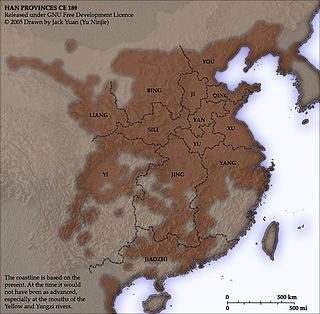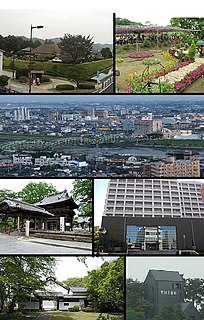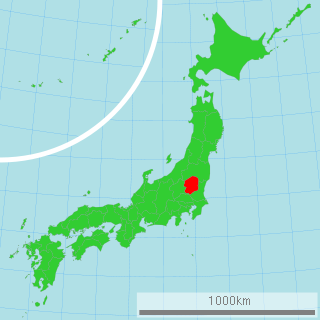
Emperor Jimmu was the first Emperor of Japan, according to legend. His accession is traditionally dated as 660 BC. According to Japanese mythology, he is a descendant of the sun goddess Amaterasu, through her grandson Ninigi, as well as a descendant of the storm god Susanoo. He launched a military expedition from Hyuga near the Seto Inland Sea, captured Yamato, and established this as his center of power. In modern Japan, Jimmu's accession is marked as National Foundation Day on February 11.

Sichuan, is a province in southwest China occupying most of the Sichuan Basin and the easternmost part of the Tibetan Plateau between the Jinsha River on the west, the Daba Mountains in the north, and the Yungui Plateau to the south. Sichuan's capital city is Chengdu. The population of Sichuan stands at 81 million.
There are traditionally four historical capitals of China, collectively referred to as the "Four Great Ancient Capitals of China". The four are Beijing, Nanjing, Luoyang and Xi'an (Chang'an).

Provinces of Japan were administrative divisions before the modern prefecture system was established, when the islands of Japan were divided into tens of kuni, usually known in English as provinces. Each province was divided into gun.
Himiko or Pimiko was a shamaness-queen of Yamataikoku in Wa (Japan). Early Chinese dynastic histories chronicle tributary relations between Queen Himiko and the Cao Wei Kingdom (220–265), and record that the Yayoi period people chose her as ruler following decades of warfare among the kings of Wa. Early Japanese histories do not mention Himiko, but historians associate her with legendary figures such as Empress Consort Jingū, who was regent in roughly the same era as Himiko. Scholarly debates over the identity of Himiko and the location of her domain, Yamatai, have raged since the late Edo period, with opinions divided between northern Kyūshū or traditional Yamato province in present-day Kinki. The "Yamatai controversy," writes Keiji Imamura (1996:188), is "the greatest debate over the ancient history of Japan."

Shimotsuke Province was a province of Japan in the area of Japan that is today Tochigi Prefecture. Shimotsuke was bordered by Kōzuke, Hitachi, Mutsu and Shimōsa Provinces. Its abbreviated form name was Yashū (野州). Under the Engishiki classification system, Shimotsuke was ranked as one of the 13 "great countries" (大国) in terms of importance, and one of the 30 "far countries" (遠国) in terms of distance from the capital. The provincial capital is located in what is now the city of Tochigi. The Ichinomiya of the province is the Futarasan jinja located in what is now the city of Utsunomiya.

Taiyuan is the capital and largest city of Shanxi province in China. It is one of the main manufacturing bases of China. Throughout its long history, Taiyuan was the capital or provisional capital of many dynasties in China, hence the name Lóngchéng.

Zhou were historical political divisions of China. Formally established during the Han dynasty, zhou exist continuously until the establishment of the Republic of China in 1912—a period of over 2000 years. Zhou were also previously used in Korea, Vietnam, and Japan.

Wa is the oldest recorded name of Japan. The Chinese as well as Korean and Japanese scribes regularly wrote it in reference to Yamato with the Chinese character 倭 "Dwarf", until the 8th century, when the Japanese replaced it with 和 "harmony, peace, balance."

The Ryōmō Line is a Japanese railway line connecting Oyama in Tochigi Prefecture with Maebashi in Gunma Prefecture. 84.4 km (52.4 mi) long, the line is owned and operated by the East Japan Railway Company. The name refers to the fact that Gunma and Tochigi prefectures were once part of an ancient province called Keno (毛野), which was later split into Kōzuke (Gunma) and Shimotsuke (Tochigi). This line connects both halves of the old province.

Xiangxi Tujia and Miao Autonomous Prefecture is an autonomous prefecture of the People's Republic of China. It is located in western Hunan province. It consists of 1 city, Jishou, and 7 counties: Baojing, Fenghuang, Guzhang, Huayuan, Longshan, Luxi, Yongshun. The capital is Jishou. Twenty-five nationalities gather here, of the total 2,480,000 population, 66.6 per cent are ethnic minorities, including 860,000 Tujia and 790,000 Miao.
Yamatai-koku (邪馬台国) or Yamato-koku (邪馬臺国)(c. 1st century –c. 3rd century) is the Sino-Japanese name of an ancient country in Wa (Japan) during the late Yayoi period (c. BC 300 –c. 300 AD). The Chinese text Records of the Three Kingdoms first recorded as Yamatai guo or Yemayi guo as the domain of Priest-Queen Himiko. Generations of Japanese historians, linguists, and archeologists have debated where Yamatai-koku was located and whether it was related to the later Yamato (大和).

Japanese Shinjūkyō is an ancient type of round bronze mirror decorated with images of gods and animals from Chinese mythology. The obverse side has a polished mirror and the reverse has relief representations of legendary Chinese shen, Xian, and legendary creatures.

Ashikaga is a city located in Tochigi Prefecture, Japan. As of May 2015, the city had an estimated population of 149,711, and a population density of 842 persons per km². Its total area is 177.76 km².

The King of Na gold seal is a solid gold seal discovered in the year 1784 on Shikanoshima Island in Fukuoka Prefecture, Japan. The seal is designated as a National Treasure of Japan. The seal is believed to have been cast in China and bestowed by Emperor Guangwu of Han upon a diplomatic official (envoy) visiting from Japan in the year 57 AD. The five Chinese characters appearing on the seal identify it as the seal of the King of Na state of Wa (Japan), vassal state of the Han Dynasty. The seal is currently in the collection of the Fukuoka City Museum in Fukuoka, Japan.















